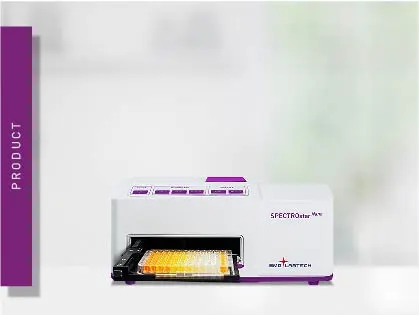
SPECTROstar Nano
Absorbance plate reader with cuvette port
Apoptosis is a form of programmed cell death responsible for the removal of damaged or unnecessary cells. As one of the most investigated processes in cell biology, it comes with a large variety of assays to monitor, with different markers, its different stages and complex pathways. Here, we highlight the most important apoptotic markers and the respective microplate-based assays.
 Dr Tobias Pusterla
Dr Tobias Pusterla
Cell death is a normal process in multicellular organisms, playing an important role in homeostasis. There are two types of cell death: necrosis (or accidental cell death), and apoptosis, a form of programmed cell death (PCD) characterized by specific morphological changes. Apoptosis is responsible for the removal of damaged or unnecessary cells throughout the lifecycle, including normal cell turnover, cell loss during embryogenesis – for instance, removing cells between fingers – negative selection by the immune system and nervous system development1. As a result, there is a wide range of apoptosis assays described in the literature.
There are two key pathways in which apoptosis can occur – the caspase (extrinsic) cascade and the mitochondrial (intrinsic) pathway. Dysregulation in one or both of these pathways is linked with a number of human diseases, including cancers, stroke, and neurodegenerative conditions such as Alzheimer’s. Dysregulation is normally due to a disruption of the balance between pro-and anti-apoptotic proteins, changes to caspase activity or altered death receptor signaling. It is therefore vital to determine the mechanism of action of apoptotic dysregulation to understand the pathogenesis of a disease. Understanding the complex regulation of cell death is also essential for the development of effective therapeutics, so it’s no wonder then that apoptosis is one of the most widely investigated processes in drug development today2.
The complex pathways seen in apoptosis mean that a number of different markers can be used to study the process. Which pathway and stage of apoptosis to follow will vary depending on your specific application, so it is important to pick the best markers for your apoptosis assay.
Mitochondrial membrane potential assay
The mitochondrial membrane potential assures ATP production during oxidative phosphorylation. As an early event during apoptosis, the mitochondrial permeability transition pore (MPTP) opens and depolarizes the membrane potential. Measuring depolarization is achieved using the JC-1 indicator. It is red fluorescent if present as aggregates in healthy mitochondria. With a decrease in mitochondrial membrane potential, JC-1 shifts to monomers that have a green fluorescence (Figure 2). The ratio of red to green fluorescence is monitored on a microplate reader and decreases along with the mitochondrial membrane potential. The application note “The CLARIOstar with ACU exposes cells to ischemia-reperfusion conditions and monitors their oxygenation” used JC-1 to measure mitochondrial membrane potential.
Similarly, the fluorescent dyes Rhodamine 123 or TMRE can be used to measure mitochondrial membrane potential. Both substances accumulate in the healthy mitochondrial membrane and cannot bind if the membrane potential is disrupted. During this apoptosis assay, cells are stained with Rhodamine 123 or TMRE and excess dye is removed by washing. The fluorescence intensity is measured on a microplate reader and loss of membrane potential which occurs during apoptosis is reported by a decrease in fluorescence.
Cytochrome c release assays
Cytochrome c – a mitochondrial protein – plays roles in both cellular metabolism and apoptosis4. The protein interacts with apoptotic protease activating factor-1 (Apaf-1) in the cytosol to initiate the proteolytic maturation of caspase-9 and the death protease caspase-3. During early apoptosis in course of the opening of the mitochondrial permeability transition pore (MPTP), cytochrome c is released into the cytosol and is used as a marker for PCD. Quantifying cytochrome c in cytosolic and mitochondrial cell extracts is quantified by western blot or microplate readers in order to measure apoptosis.
Caspase activity assays
Caspases belong to a large family of proteins that are involved with inflammation or apoptosis. They are constitutively expressed in most cell types as inactive zymogens that require proteolytic processing before they can be fully active. In humans, initiator caspases (caspase-2, -8, -9, and -10) are signaling proteins that initiate the process of apoptosis by activating effector caspases through proteolytic processing. Effector caspases – such as caspase-3, -6, and -7 – are vital to apoptosis, directing cell death itself by cleaving downstream targets including many vital cellular proteins and breaking up the nuclear scaffold and cytoskeleton. They also activate DNase, which further degrades nuclear DNA, causing cell death2. Artificial caspase substrates can be designed which contain cleavage sequences specific for different caspases (figure 3).
Annexin V assays
The appearance of PS residues on the surface of a cell can be used to measure apoptosis. In healthy cells, PS is located on the cytoplasmic surface of the plasma membrane. During early PCD, structural changes to the plasma membrane occur, including translocation of PS from the inner to the outer leaflet of the plasma membrane, potentially acting as a marker for phagocytosis by macrophages without the release of pro-inflammatory cellular components2. Annexin V – a cellular protein – has a strong Ca2+-dependent affinity for PS, and can therefore be used as a probe for PS on the outer leaflet of the plasma membrane, to detect cells undergoing apoptosis3. The method of Annexin V binding to PS on the outer membrane is employed by a luminescence-based apoptosis assay. Annexin V is linked to two different, non-functional luciferase parts. Only if apoptosis occurs Annexin V binds the cell and both luciferase parts bind, a functional luciferase can be formed by the two parts (figure 4). Hence, luminescence reports on apoptosis induction and can be quantified by a luminescence plate reader. In the microplate-based assay increase in luminescence reports on apoptosis induction. Details are found in the application note “Real-time assessment of apoptosis and necrosis”.
Novel approaches utilise biocytometry to detect apoptotic cells specifically in a subpopulation of cells. A luminescent reporter signal is generated upon binding of bioparticles to specific antigens on cells surface.
DNA fragmentation assays
DNA fragmentation occurs where genomic DNA is cleaved and is a late point of apoptosis. Assays labelling the ends of genomic fragments, such as a dT-mediated dUTP Nick End Labeling (TUNEL) assay, can use colorimetric or fluorescent detection to study apoptosis in cells1. The enzyme terminal deoxynucleotidyl transferase (TdT) adds nucleotides to 3'-hydroxyl termini. It adds fluorescently labelled nucleotides or horseradish peroxidase-linked nucleotides, producing a fluorescent or colorimetric signal. The more nucleotides are included, the further has apoptotic DNA fragmentation progressed and the higher is the signal. Analysis is either done microscopically or in a microplate reader. TUNEL assays compatible with BMG LABTECH microplate readers are available from various suppliers (Table 1).
More specific approaches also use extracellular ATP to detect immunogenic cell death driven apopotosis. This was successfully demonstrated in the AppNote: Extracellular ATP measurement in real time using living cells exploiting the incubation features of the CLARIOstar.
Real-time apoptosis assays and multiplexing
Traditional experimental approaches to study apoptosis are often time-consuming, labour intensive, expensive, and don’t generate appropriate data. Conventional endpoint cell health methods are not efficient when multiple assays are required to study different time points, and the use of resources is very high in these cases. Additionally, as no single parameter fully defines cell death in all systems, using several different approaches has advantages. Running different assays sequentially – studying one parameter followed by another in different plates – is one solution, but the increased time and consumable costs are major drawbacks of this approach, especially as cell culture is already relatively expensive. Cell-based assays are also especially vulnerable to cell growth and metabolism variations between cells in different plates.
Measuring in real-time lowers resource costs and reduces the need for multiple assays with different endpoints, ensuring that no timepoints are missed and data is continuously collected. Multiplexing provides the opportunity to measure several parameters in the same well, minimizing the consumption of valuable test compounds while saving time and reducing consumable costs. These assays are especially useful when studying cell viability such as apoptosis and necrosis, allowing specific stages to be recognized in the process and improving assay results. The real-time nature of the results allows the easy capture of information that would require extensive effort using previous apoptosis assay techniques. Additionally, fewer cells are needed to acquire the same amount of data, and data is more precise. In this way, apoptosis assays can be combined with other related assays – for instance, cell viability and cytotoxicity assays – to provide more information about mechanisms of cell death on a single sample5,6.
Given the number of different markers to study different stages of apoptosis, it is no surprise that a huge variety of assays exist from different companies. Below is a small selection of available microplate-based kits and their markers to give a flavour of what’s out there.
|
Apoptosis marker
|
Commercial kits
|
Detection mode
|
|
Mitochondrial membrane potential
|
JC-1 Dye (Mitochondrial Membrane Potential Probe; ThermoFisher Scientific)
JC-10 Mitochondrial Membrane Potential Assay Kit (Microplate; abcam)
Rhodamine 123 and TMRE are available from common life science chemicals providers
|
Fluorescence
|
|
Cytochrome c release
|
Human Cytochrome C ELISA Kit (SimpleStep ELISA by abcam)
Cytochrome C Human ELISA Kit (ThermoFisher Scientific)
|
Absorbance
|
|
Caspase activity
|
Caspase 3 Assay Kit, Colorimetric (SigmaAldrich)
Caspase-Glo 3/7 (Promega)
Molecular Probes™ EnzChek™ Caspase-3 Assay-Kit (ThermoFisher Scientific)
|
|
|
Phosphatiylserine on membrane surface
|
RealTime-Glo™ Annexin V Apoptosis and Necrosis Assay (Promega)
|
Luminescence (apoptosis), fluorescence (necrosis
|
|
DNA fragmentation
|
Click-iT® TUNEL Alexa Fluor® (ThermoFisher Scientific)
Cell Meter(TM) TUNEL Apoptosis Assay Kit (AAT Bioquest)
|
Fluorescence
|
Cell viability assays require a microplate reader that is sensitive and can generate a lot of data. BMG LABTECH’s CLARIOstar Plus and VANTAstar with Atmospheric Control Unit (ACU) offer the control needed for cell viability assays, regulating temperature, CO2, and O2 levels to ensure cells are maintained in an appropriate environment. The system offers the best sensitivity of its class and features the newly developed Enhanced Dynamic Range technology, as well as multiple shaking, well scan, and reagent injectors, making it the ideal platform for any live cell-based assay. This enables novel methodologies to be carried out and real-time data to be captured, offering a true walk-away solution5,7.
Not sure what marker or apoptosis assay to use or what is best to measure for your application? Contact BMG for all your apoptosis queries, and we can point you in the right direction.
Absorbance plate reader with cuvette port
Powerful and most sensitive HTS plate reader
Most flexible Plate Reader for Assay Development
Upgradeable single and multi-mode microplate reader series
Flexible microplate reader with simplified workflows
Learn about applications for bacterial metabolism on a microplate reader.
Life in the depths of the ocean operates under extreme conditions. Find out how proteins from deep-sea luminescent organisms are useful for measurements on microplate readers.
Second messengers play a pivotal role in signal transduction events in cells. But how do you measure these small, transiently lived molecules and how can microplate readers help?
NanoBRET is used to analyse binding events, signaling pathways and receptor trafficking in live cells and has significantly expanded the range and applications of BRET assays.
Find out about the different types of cell-based assays and why they have become an indispensable tool in a such a broad variety of disciplines in this blog article.
Read here about the various threats associated with mycoplasma contamination and find out about methods to prevent, detect, and eliminate mycoplasma in your cell culture.